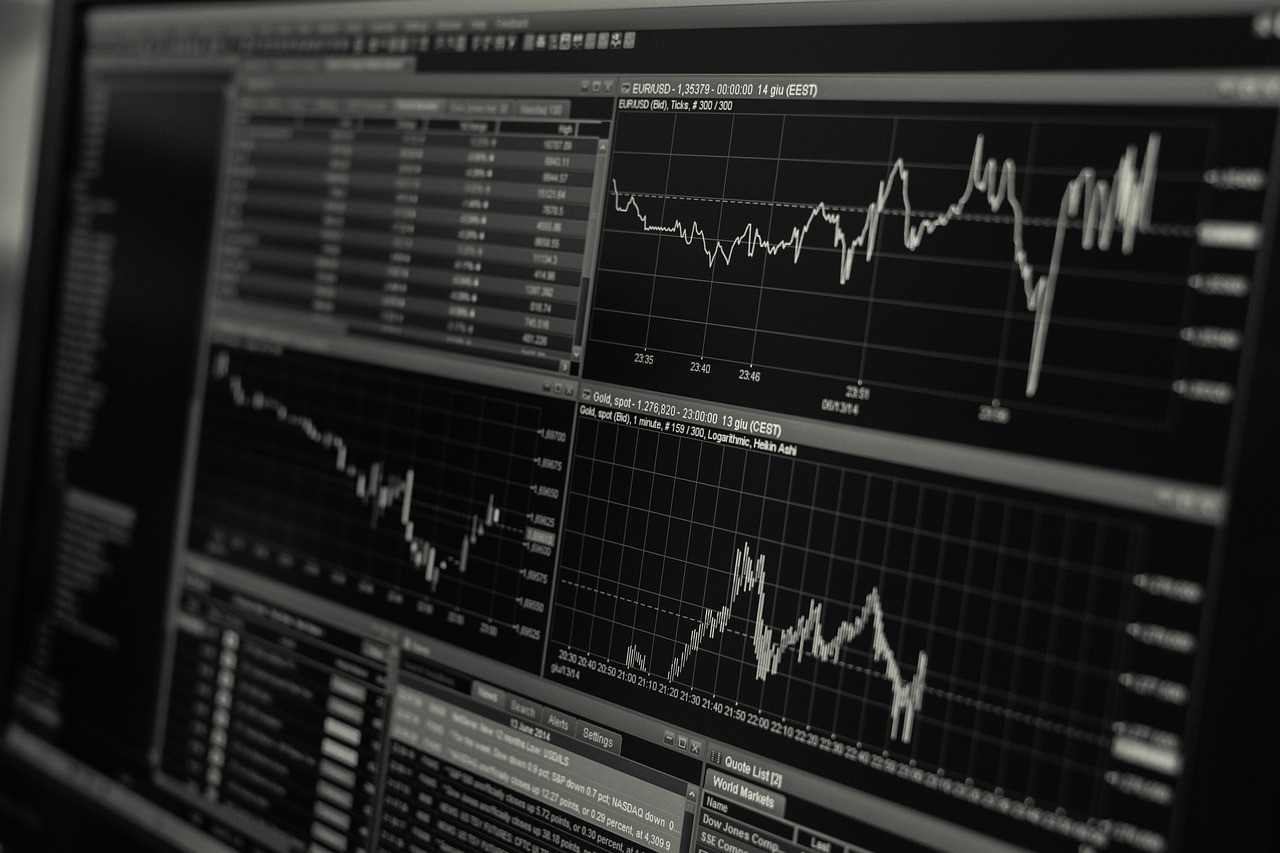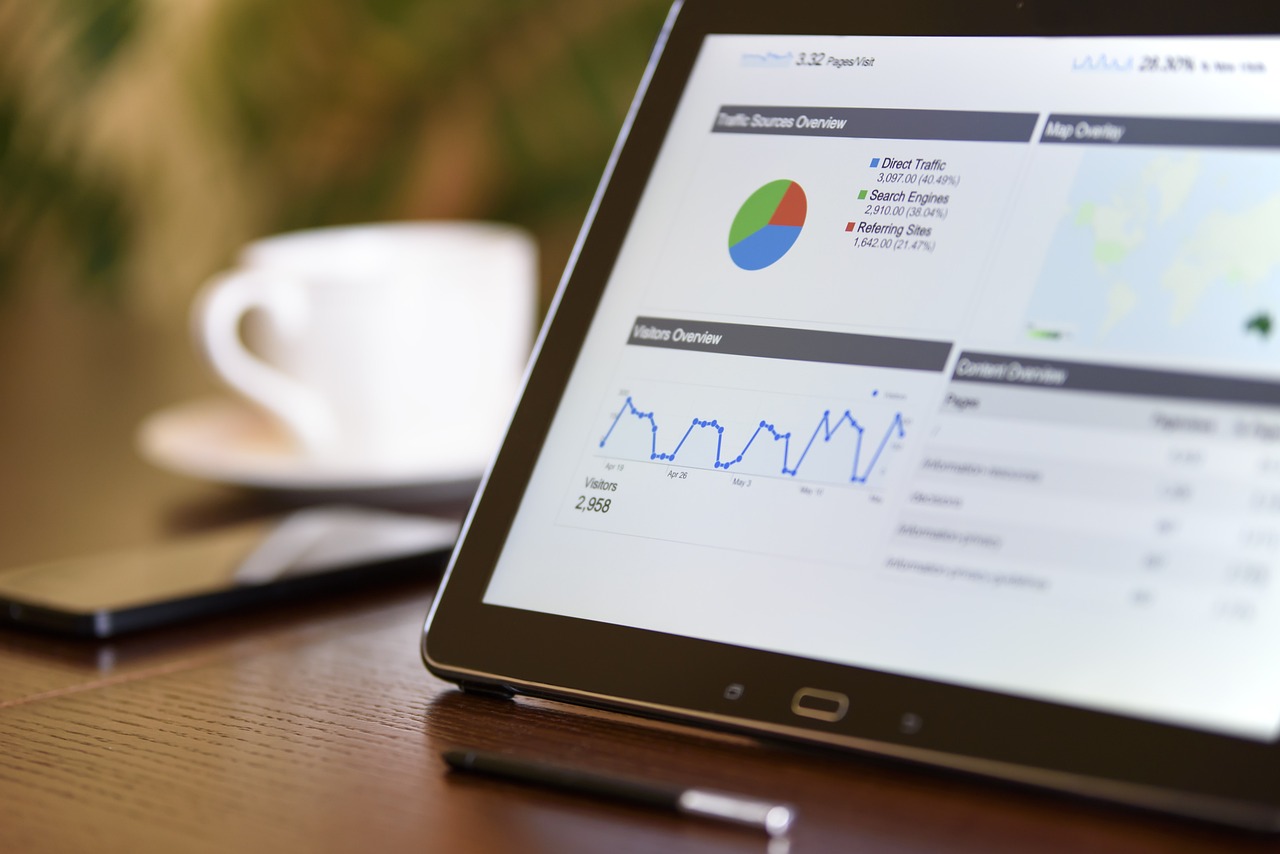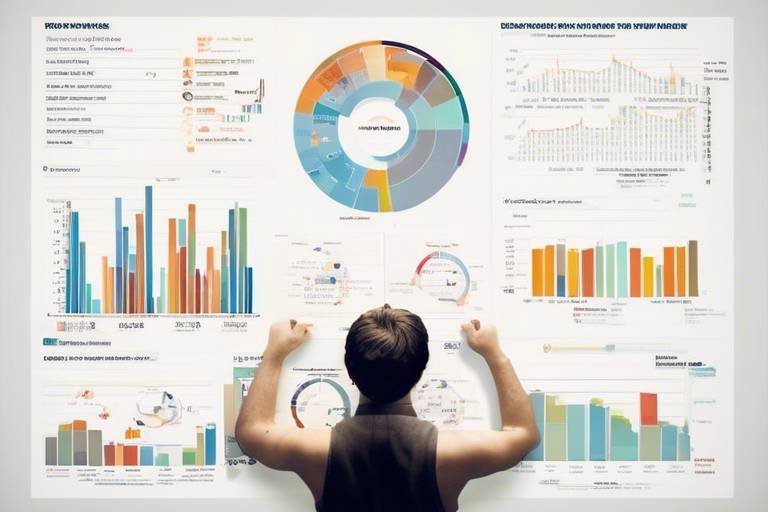How to Use Data Visualization for Market Analysis
In today's fast-paced business environment, making informed decisions is crucial for success. One of the most effective ways to achieve this is through data visualization. By transforming raw data into visual formats, we can unveil insights that might otherwise remain hidden in spreadsheets and reports. Imagine trying to find a needle in a haystack; that’s what analyzing data can feel like without the right tools. Data visualization acts as a magnet, drawing our attention to trends and patterns that inform our strategies and decisions.
Data visualization is not just about making pretty pictures; it’s about enhancing our understanding of complex data sets. When we visualize data, we engage our brains in a way that raw numbers simply can't. This is particularly important in market analysis, where the stakes are high, and the competition is fierce. By leveraging visualization techniques, businesses can quickly identify market trends, customer preferences, and potential opportunities. In essence, it allows analysts to tell a story with data, making it easier for stakeholders to grasp essential insights and make strategic decisions.
Moreover, the significance of data visualization extends beyond just internal decision-making. It plays a vital role in communicating findings to clients, stakeholders, and team members. A well-crafted visualization can convey complex information in a straightforward manner, fostering better understanding and collaboration. Think of it as a universal language that transcends barriers—everyone can appreciate a clear visual representation of data, regardless of their technical background.
As we delve deeper into the world of data visualization for market analysis, we will explore various techniques and tools that can enhance our ability to interpret and communicate market trends effectively. From bar charts to heat maps, each method offers unique advantages, helping us to present data in a way that resonates with our audience. So, buckle up as we embark on this journey to unlock the power of data visualization!
Data visualization transforms complex data into visual formats, making it easier to understand trends and patterns in market analysis. This section discusses its critical role in decision-making and strategic planning.
Various visualization techniques can be employed for market analysis, including bar charts, line graphs, and heat maps. This section outlines the most effective methods for presenting market data clearly and concisely.
Bar charts are ideal for comparing quantities across different categories. This subheading delves into their advantages and best practices for using them effectively in market analysis.
To create compelling bar charts, consider aspects like color choice, labeling, and scale. This section provides tips for enhancing clarity and impact in your visualizations.
Avoid pitfalls like cluttered designs and misleading scales in bar charts. This segment highlights frequent errors and how to steer clear of them for accurate market representation.
Heat maps offer a visually striking way to represent data density and trends over time. This subheading explores their applications in market analysis and how to interpret them effectively.
Selecting appropriate tools is crucial for effective data visualization. This section reviews popular software options and their features, helping analysts choose the best fit for their needs.
A comparison of various data visualization software can aid in decision-making. This subheading evaluates popular tools based on usability, features, and pricing, guiding users to the best choice.
Combining visualization tools with data analysis software can enhance insights. This section discusses how to integrate different platforms for a comprehensive market analysis approach.
As we wrap up this exploration of data visualization for market analysis, you might have some questions swirling in your mind. Here are a few frequently asked questions that can help clarify any lingering doubts:
- What is data visualization? Data visualization is the graphical representation of information and data, making complex data more accessible and understandable.
- Why is data visualization important for market analysis? It helps in identifying trends, patterns, and insights that can inform strategic decisions, making it easier to communicate findings to stakeholders.
- What are some common data visualization tools? Popular tools include Tableau, Power BI, Google Data Studio, and Excel, each offering unique features for data representation.
- How do I choose the right visualization technique? Consider the nature of your data and the message you want to convey. For comparison, bar charts are great, while heat maps work well for displaying data density.

The Importance of Data Visualization
In today's fast-paced world, where data is generated at an unprecedented rate, the ability to make sense of that data is crucial. Data visualization plays a pivotal role in transforming complex datasets into easily digestible visual formats. Imagine trying to read a lengthy report filled with numbers and statistics—overwhelming, right? Now, think about how much easier it would be if those figures were represented through colorful charts or graphs. This is where data visualization steps in, acting as a bridge between raw data and insightful information.
Data visualization not only enhances understanding but also aids in decision-making and strategic planning. When market analysts present data visually, they can quickly identify trends, correlations, and outliers that might be missed in traditional reports. For instance, a line graph showing sales over time can reveal seasonal trends at a glance, while a bar chart comparing market shares can highlight competitive positioning. By making these insights accessible, organizations can respond swiftly to market demands and adjust their strategies accordingly.
Moreover, the significance of data visualization extends beyond mere comprehension; it fosters communication and collaboration among teams. When stakeholders can visually interpret data, they are more likely to engage in discussions and brainstorming sessions that lead to innovative solutions. In essence, effective data visualization acts as a common language, breaking down barriers and aligning teams towards shared objectives.
To illustrate the impact of data visualization further, consider the following key benefits:
- Enhanced Clarity: Visual representations simplify complex information, making it easier for audiences to grasp essential points.
- Faster Decision-Making: Quick visual insights enable teams to make informed decisions without wading through pages of data.
- Increased Engagement: Well-designed visuals capture attention and encourage deeper exploration of the data.
- Improved Retention: People are more likely to remember information presented visually than text-heavy reports.
In summary, the importance of data visualization in market analysis cannot be overstated. It empowers organizations to navigate through vast amounts of data, uncover valuable insights, and communicate findings effectively. As we delve deeper into the various techniques and tools available for data visualization, keep in mind that the ultimate goal is to turn data into a powerful narrative that drives business success.

Types of Data Visualization Techniques
When it comes to market analysis, data visualization techniques play a pivotal role in transforming raw data into comprehensible insights. Imagine trying to decipher a complex puzzle without a picture; it would be nearly impossible! Similarly, data visualization acts as that picture, allowing analysts to spot trends, patterns, and anomalies with ease. Various techniques can be employed to convey this information, each with its unique strengths and applications. Let's dive into some of the most effective methods that can elevate your market analysis to new heights.
One of the most popular techniques is the bar chart, which is perfect for comparing quantities across different categories. Bar charts provide a clear visual representation that makes it easy to see differences at a glance. For instance, if you're analyzing sales figures across various regions, a bar chart can quickly illustrate which areas are performing well and which are lagging behind. However, bar charts are just the tip of the iceberg. Another powerful technique is the line graph, which is particularly useful for showing trends over time. Picture tracking your favorite stock's performance; a line graph allows you to visualize its ups and downs seamlessly.
Heat maps are another striking visualization technique that can effectively represent data density and trends over time. They use color gradients to indicate intensity, making it visually engaging and easy to interpret. For example, a heat map can show customer activity on a website, highlighting peak hours and areas of interest. This technique not only captures attention but also conveys complex data in a digestible format.
To further illustrate the effectiveness of these techniques, consider the following table that compares the primary characteristics of bar charts, line graphs, and heat maps:
| Technique | Best For | Advantages | Common Use Cases |
|---|---|---|---|
| Bar Chart | Comparing quantities across categories | Easy to read, visually engaging | Sales comparisons, survey results |
| Line Graph | Showing trends over time | Clear representation of changes, intuitive | Stock prices, website traffic |
| Heat Map | Representing data density | Visually striking, easy to interpret | Customer activity, geographical data |
Each of these techniques has its own unique flair, and understanding when to use each one can significantly enhance your market analysis. Whether you're presenting your findings to stakeholders or simply trying to make sense of data for your own understanding, the right visualization can make all the difference. So, the next time you're faced with a mountain of data, remember that the right visualization technique can turn that mountain into a series of manageable hills, making it much easier to climb!
- What is data visualization? - Data visualization is the graphical representation of information and data, allowing for easier understanding and analysis.
- Why is data visualization important for market analysis? - It helps identify trends, patterns, and correlations in data, enabling informed decision-making.
- Which data visualization technique is the best? - The best technique depends on the data and the message you want to convey; bar charts, line graphs, and heat maps each serve different purposes.

Bar Charts
Bar charts are one of the most effective tools in the data visualization arsenal, especially when it comes to market analysis. They allow analysts to compare quantities across different categories quickly and intuitively. Imagine standing in front of a colorful display of data, where each bar tells its own story. This visual representation not only captures attention but also makes complex data more digestible. Whether you're comparing sales figures, customer demographics, or product performance, bar charts can simplify the narrative behind the numbers.
One of the key advantages of bar charts is their clarity. They present data in a straightforward manner, making it easy for stakeholders to grasp essential insights at a glance. For instance, if you're analyzing quarterly sales data across several regions, a bar chart can clearly illustrate which regions are performing well and which ones are lagging. This immediate visual feedback can be crucial for making informed decisions about resource allocation or marketing strategies.
When creating bar charts, there are a few best practices to keep in mind to ensure your visualizations are as impactful as possible. First, consider the color choice. Colors can evoke emotions and draw attention, so choose a palette that enhances the message you're trying to convey. For example, using a bold color for the highest bar can highlight its significance. Additionally, labeling is vital; each bar should have clear labels that indicate what they represent, helping viewers quickly understand the data without confusion. Finally, pay attention to the scale of your chart. A well-designed scale can prevent misinterpretation of the data and ensure that your audience accurately perceives differences between categories.
However, while bar charts are incredibly useful, there are common mistakes that can undermine their effectiveness. One such mistake is cluttering the design with unnecessary elements, which can distract from the data itself. Keep it simple! A clean design ensures that the focus remains on the data you want to highlight. Another frequent pitfall is using misleading scales. For instance, if the y-axis starts at a number higher than zero, it can exaggerate differences between bars, leading to misinterpretation. Always ensure that your scales are consistent and accurately represent the data.
In summary, bar charts serve as a powerful means to visualize market data, offering clarity and immediate insights. When designed thoughtfully, they can communicate complex information effectively. So, the next time you're faced with a mountain of data, consider transforming it into a bar chart that not only informs but also engages your audience.
- What types of data are best suited for bar charts? Bar charts are ideal for categorical data where you want to compare different groups or categories.
- How can I make my bar charts more visually appealing? Use contrasting colors, clear labels, and avoid clutter to enhance the visual appeal of your bar charts.
- What software can I use to create bar charts? There are numerous tools available, including Excel, Tableau, and Google Charts, which make it easy to create professional-looking bar charts.

Creating Effective Bar Charts
When it comes to , a few key elements can make all the difference in how your data is perceived. Think of a bar chart as a storybook for your data; if the visuals are engaging and clear, your audience will be drawn in and eager to understand the narrative you're presenting. Here are some crucial aspects to consider:
Color Choice is paramount. Just like an artist selects a palette to evoke emotions, your choice of colors can influence how viewers interpret your data. Using contrasting colors for the bars can help differentiate categories, while a consistent color scheme enhances overall coherence. For example, if you're comparing sales data across different regions, you might choose a distinct color for each region, making it easy for viewers to spot trends at a glance.
Next up is labeling. Clear and concise labels are the backbone of any effective bar chart. Without them, your audience may find themselves lost in a sea of data. Ensure that each bar is labeled with its corresponding value, and consider adding a descriptive title that encapsulates the essence of the data being presented. For instance, instead of a generic title like "Sales Data," opt for something more specific, such as "Q1 2023 Sales by Region." This not only informs the viewer but also sets the context for the data.
Another aspect to keep in mind is scale. The scale of your bar chart should be appropriate for the data being represented. If the scale is too broad, subtle differences between data points may be lost; too narrow, and it can exaggerate minor variations. A well-chosen scale allows for a balanced view of the data, making it easier for the audience to draw meaningful conclusions. Consider using a consistent scale across multiple charts for comparative analysis.
Lastly, ensure that your bar chart is free from clutter. A clean design enhances readability and comprehension. Avoid unnecessary gridlines, excessive text, and decorative elements that can distract from the main data. A minimalist approach often works best, allowing the bars themselves to take center stage. Remember, the goal is to communicate data clearly and effectively, not to overwhelm your audience with visual noise.
In summary, creating effective bar charts involves a combination of thoughtful color choices, clear labeling, appropriate scaling, and a clean design. By paying attention to these elements, you can craft bar charts that not only convey information but also engage and inform your audience, turning complex data into a compelling visual narrative.
- What is the best color scheme for bar charts? A good color scheme is one that provides high contrast between bars while remaining visually appealing. Consider using a color palette that aligns with your brand or the theme of your presentation.
- How can I avoid clutter in my bar charts? Keep your design simple by minimizing gridlines and unnecessary text. Focus on the data itself and ensure that each element serves a purpose.
- What software can I use to create bar charts? There are many options available, including Microsoft Excel, Google Sheets, and more specialized tools like Tableau and Power BI, which offer advanced visualization capabilities.

Common Mistakes to Avoid
When it comes to data visualization for market analysis, even the most experienced analysts can stumble into common traps that undermine the effectiveness of their presentations. One of the biggest mistakes is creating cluttered designs. Imagine trying to read a map filled with too many roads, each one competing for your attention. Just like that map, a cluttered chart can confuse your audience, making it difficult to extract meaningful insights. To avoid this, keep your visuals clean and focused on the key data points you want to highlight.
Another frequent pitfall is using misleading scales. For instance, if you’re displaying sales growth over several years, using a non-linear scale might exaggerate the perceived growth, leading to misinterpretations. Always ensure that your scales accurately reflect the data, as this fosters trust in your analysis. A good rule of thumb is to use consistent intervals and clearly label your axes. This way, your audience can easily grasp the trends without second-guessing your intentions.
Furthermore, neglecting proper labeling is a mistake that can cost you clarity. Think of your visualizations as a storybook; without titles, subtitles, and legends, your readers might get lost in the narrative. Always include clear labels that describe what the data represents. This not only informs your audience but also enhances the overall understanding of the visual. For example, if you’re using a bar chart to showcase sales by region, make sure each bar is labeled with the corresponding region name.
In addition to these issues, analysts often overlook the importance of color choice. Colors can evoke emotions and convey messages, so using too many colors or inappropriate color schemes can distract or mislead your audience. Stick to a limited palette that aligns with your brand or the message you want to convey. For instance, using red for losses and green for gains is a widely accepted convention that helps viewers quickly understand the context of the data.
Lastly, failing to consider the audience's perspective can lead to miscommunication. Always keep in mind who will be viewing your visualizations. Are they seasoned analysts or stakeholders without a data background? Tailor your visuals accordingly. For instance, if your audience is less familiar with data analysis, you might want to simplify your visualizations and provide additional context to help them understand the implications of the data being presented.
In summary, by avoiding these common mistakes—cluttered designs, misleading scales, poor labeling, inappropriate color choices, and neglecting the audience's perspective—you can significantly enhance the effectiveness of your data visualizations. Remember, the goal is to make complex data accessible and actionable, and steering clear of these pitfalls is a crucial step in achieving that aim.
- What are the most common data visualization mistakes?
Common mistakes include cluttered designs, misleading scales, poor labeling, inappropriate color choices, and not considering the audience's perspective.
- How can I improve my data visualizations?
Focus on clarity by simplifying designs, using appropriate scales, labeling effectively, choosing a limited color palette, and tailoring your visuals to your audience's needs.
- Why is labeling important in data visualization?
Proper labeling helps the audience understand what the data represents, enhancing clarity and ensuring accurate interpretation.

Heat Maps
Heat maps are a powerful visualization tool that can transform the way we interpret market data. Imagine walking into a room filled with numbers and statistics, only to be overwhelmed by the sheer volume of information. Now, picture that same data represented in vibrant colors, where each hue tells a story of its own. This is the magic of heat maps! They allow analysts to quickly identify trends, patterns, and anomalies in data sets by using color gradients to represent values. Whether you're analyzing sales performance across different regions or tracking website traffic over time, heat maps can provide immediate insights that might take hours to decipher through traditional data tables.
One of the most compelling aspects of heat maps is their ability to convey complex information in a visually appealing manner. For instance, a heat map can illustrate customer engagement on a website, showing which areas attract the most attention. Areas of high activity might be represented in red, while cooler zones could be shaded in blue. This color-coding not only makes it easy to spot trends at a glance but also facilitates deeper analysis. Analysts can ask questions like, "Why are users spending more time in this section?" or "What factors contribute to the drop-off in this area?" By prompting such inquiries, heat maps encourage a more thorough exploration of the data.
In market analysis, heat maps can be particularly useful in several scenarios:
- Geographical Analysis: Visualize sales data across different regions to identify high-performing areas and potential markets for expansion.
- Time Series Analysis: Track changes over time, such as seasonal trends in consumer behavior or sales fluctuations.
- Customer Segmentation: Understand how different demographics interact with products or services, allowing for targeted marketing strategies.
However, while heat maps are incredibly effective, it's essential to use them wisely. The choice of color scheme, for instance, can significantly impact the interpretation of the data. A poorly chosen palette might mislead viewers or obscure important trends. Therefore, analysts should adhere to best practices, such as ensuring sufficient contrast between colors and avoiding overly complex gradients. Additionally, providing context through labels and legends can enhance the viewer's understanding, ensuring that the insights derived from the heat map are both accurate and actionable.
In conclusion, heat maps are more than just a pretty picture; they are a vital component of modern market analysis. By transforming raw data into a visual format, they enable analysts and decision-makers to quickly grasp complex information, identify trends, and make informed decisions. As we continue to navigate an increasingly data-driven world, leveraging tools like heat maps will be crucial for staying ahead of the competition.

Choosing the Right Tools for Visualization
When it comes to data visualization for market analysis, selecting the right tools is absolutely crucial. With so many options available, it can feel overwhelming, like trying to find a needle in a haystack. However, the right tool can make all the difference in turning raw data into compelling visuals that tell a story. So, how do you choose? First, consider your specific needs. Are you looking for something that offers advanced features, or do you need a straightforward tool that anyone on your team can use? Understanding your requirements is the first step in making an informed decision.
There are several popular software options that cater to different levels of expertise and types of data. Some tools are designed for beginners and offer user-friendly interfaces, while others provide advanced functionalities for seasoned analysts. Here are a few key players in the market:
| Software | Usability | Features | Pricing |
|---|---|---|---|
| Tableau | Intermediate to Advanced | Interactive dashboards, real-time data analysis | Starts at $70/month |
| Microsoft Power BI | Beginner to Intermediate | Data modeling, collaboration features | Starts at $9.99/month |
| Google Data Studio | Beginner | Free, easy integration with Google products | Free |
| QlikView | Intermediate to Advanced | Associative data models, in-memory processing | Custom pricing |
As you can see from the table above, each tool has its own strengths and weaknesses. For instance, if you're just starting out and need something that integrates seamlessly with Google products, Google Data Studio could be your best bet. On the other hand, if you're looking for something more robust with interactive capabilities, Tableau might be the way to go.
Another important aspect to consider is how well the visualization tool integrates with other data analysis software you may already be using. For instance, if you are working with large datasets, you might want a tool that can easily connect to SQL databases or even Excel. The ability to pull in data from various sources can enhance your market analysis significantly.
Moreover, don't overlook the importance of collaboration features. In today's world, where teams are often distributed, having a tool that allows multiple users to access and edit visualizations can be a game-changer. Look for options that offer cloud-based solutions or sharing capabilities, so your insights can be easily communicated across your organization.
In summary, choosing the right visualization tool for market analysis isn't just about picking the most popular option. It's about finding the one that fits your specific needs, enhances your analytical capabilities, and allows for collaboration within your team. With the right tool in hand, you'll be well on your way to transforming complex data into meaningful insights that drive strategic decisions.
- What is data visualization? Data visualization is the graphical representation of information and data, making complex data more accessible and understandable.
- Why is data visualization important for market analysis? It helps in identifying trends, patterns, and insights that can inform strategic decisions and improve business outcomes.
- Can I use free tools for data visualization? Yes, there are several free tools like Google Data Studio that offer robust features for data visualization.
- What should I consider when choosing a visualization tool? Consider usability, features, integration capabilities, and pricing to find the best fit for your needs.

Software Comparison
When it comes to data visualization for market analysis, choosing the right software can make all the difference. With a plethora of options available, it can be overwhelming to determine which tool is best suited for your specific needs. Let's break down some of the most popular data visualization software, comparing them based on usability, features, and pricing. This way, you can make an informed decision and elevate your market analysis game.
First off, Tableau stands out as a leader in the data visualization space. Its intuitive drag-and-drop interface makes it user-friendly, even for those who may not be tech-savvy. Tableau allows users to create stunning visualizations and dashboards that can be shared across teams, fostering collaboration. However, it does come with a higher price tag, which might be a consideration for small businesses.
On the other hand, Microsoft Power BI offers a robust alternative at a more affordable price. With seamless integration into the Microsoft ecosystem, it’s a natural choice for organizations already using tools like Excel. Power BI provides powerful analytics capabilities and a variety of visualization options, making it an excellent choice for those who need detailed insights without breaking the bank.
For those seeking a free option, Google Data Studio is worth exploring. It’s particularly appealing for small businesses or startups. While it may lack some advanced features of its competitors, it allows users to create dynamic, interactive dashboards and reports using data from various Google services. Its collaborative features are a bonus, enabling teams to work together in real-time.
To give you a clearer picture, here’s a quick comparison table summarizing the key features of these tools:
| Software | Usability | Key Features | Pricing |
|---|---|---|---|
| Tableau | High | Interactive dashboards, extensive data connectors | Starting at $70/month |
| Microsoft Power BI | Medium | Integration with Microsoft tools, real-time data access | Starting at $9.99/month |
| Google Data Studio | Medium | Free to use, collaboration features, customizable reports | Free |
Now, let’s talk about integration. Many businesses find it beneficial to combine their visualization tools with data analysis software. For instance, integrating Tableau with R or Python can enhance your analytical capabilities, allowing for deeper insights and more complex visualizations. Similarly, Power BI works seamlessly with Azure and SQL databases, enabling users to pull in data effortlessly for real-time analysis.
Ultimately, the software you choose should align with your specific needs and budget. Whether you require advanced features for in-depth analysis or a straightforward tool for basic visualizations, there’s a solution out there for you. Don't hesitate to explore free trials or demos to find the perfect fit for your market analysis endeavors!
- What is data visualization? Data visualization is the graphical representation of information and data, allowing users to see trends, patterns, and insights through visual tools.
- Why is data visualization important for market analysis? It simplifies complex data, making it easier to interpret and communicate findings, which is crucial for decision-making and strategy formulation.
- Can I use free software for data visualization? Yes, there are several free options available, such as Google Data Studio, which can be effective for basic data visualization needs.
- How do I choose the right data visualization tool? Consider factors like usability, features, integration capabilities, and pricing to find the best tool that meets your specific requirements.

Integrating Visualization with Other Tools
Integrating data visualization with other analytical tools is like adding a turbocharger to a car; it enhances performance and enables you to uncover insights that might otherwise remain hidden in raw data. When you combine visualization techniques with data analysis software, you create a powerful synergy that not only improves your understanding of the market but also streamlines the decision-making process. Imagine sifting through mountains of data without a clear visual representation—it's overwhelming, right? But with the right tools working together, you can transform that chaos into clarity.
One of the most effective ways to achieve this integration is through the use of APIs (Application Programming Interfaces). These allow different software systems to communicate and share data seamlessly. For instance, you might pull data from a customer relationship management (CRM) system and visualize it in a dashboard to track sales trends over time. This real-time data flow ensures that your visualizations are always up-to-date, providing you with the most accurate insights possible.
Moreover, many data visualization tools come equipped with built-in integrations for popular data analysis software. For example, tools like Tableau and Power BI can easily connect to databases like SQL Server, Google Analytics, or even cloud-based platforms like AWS. This connectivity allows analysts to create dynamic, interactive dashboards that respond to user input, making it easier to explore data from multiple angles.
To illustrate the benefits of integrating visualization with other tools, consider the following table:
| Tool | Integration Capability | Benefits |
|---|---|---|
| Tableau | Connects with SQL, Google Analytics, Salesforce | Real-time data updates, interactive dashboards |
| Power BI | Integrates with Excel, Azure, SharePoint | Familiar interface, collaboration features |
| Google Data Studio | Links with Google Ads, Google Sheets | Free to use, easy sharing options |
By leveraging these integrations, you can create a more cohesive workflow where data flows effortlessly from one tool to another. This not only saves time but also enhances the accuracy of your visualizations. For example, if you're using Excel to analyze sales data, integrating it with a visualization tool allows you to create compelling charts and graphs without having to export and reformat your data manually.
Additionally, integrating visualization with other tools can lead to enhanced collaboration among team members. Imagine a scenario where marketing, sales, and product development teams all access the same visual data representation. This fosters a shared understanding of market dynamics and encourages data-driven discussions, ultimately leading to better strategic decisions.
In conclusion, integrating data visualization with other analytical tools is not just a nice-to-have; it's a necessity in today's fast-paced market environment. By doing so, you empower yourself and your team to make informed decisions quickly, adapt to changing market conditions, and ultimately drive success in your business endeavors.
- What are the key benefits of integrating data visualization with other tools?
Integrating data visualization with other tools allows for real-time data updates, enhances collaboration, and provides a clearer understanding of complex data sets, leading to more informed decision-making.
- Can I use free tools for data visualization integration?
Yes, there are several free tools available, such as Google Data Studio, that offer integration capabilities with other platforms, making it accessible for businesses with limited budgets.
- How do I choose the right tools for integration?
Consider factors such as compatibility with existing systems, user-friendliness, and the specific needs of your analysis when selecting tools for integration.
Frequently Asked Questions
- What is data visualization?
Data visualization is the graphical representation of information and data. By using visual elements like charts, graphs, and maps, it helps to make complex data more accessible, understandable, and usable. Imagine trying to decipher a sea of numbers; data visualization is like a lighthouse guiding you through the fog!
- Why is data visualization important for market analysis?
It plays a crucial role in market analysis by transforming raw data into visual formats that reveal trends and patterns. This clarity aids decision-making and strategic planning, allowing businesses to quickly grasp market dynamics and make informed choices. Think of it as turning a complicated recipe into a simple step-by-step guide!
- What are some common data visualization techniques?
Some popular techniques include bar charts, line graphs, heat maps, and pie charts. Each method serves a different purpose; for instance, bar charts are great for comparing quantities, while heat maps visualize data density. Choosing the right technique is like picking the right tool for a job—each has its strengths!
- How can I create effective bar charts?
To create compelling bar charts, focus on aspects like color choice, clear labeling, and appropriate scaling. Ensure that your chart is not cluttered and that it accurately represents the data. Think of it as dressing up for an event—presentation matters!
- What mistakes should I avoid in data visualization?
Avoid cluttered designs, misleading scales, and overly complex visuals. These pitfalls can confuse your audience and distort the message you're trying to convey. Imagine trying to read a map that’s filled with too much detail—it's just frustrating!
- What tools can I use for data visualization?
There are many tools available for data visualization, including Tableau, Microsoft Power BI, and Google Data Studio. Each tool has unique features, so consider your specific needs and budget when choosing one. It's like shopping for a car; you want to find the one that fits your lifestyle best!
- How do I integrate visualization tools with data analysis software?
Integrating visualization tools with data analysis software can enhance your insights. Look for platforms that offer seamless integration options, allowing you to combine data processing and visualization in one workflow. Think of it as mixing the right ingredients for a perfect dish—everything just works better together!



















